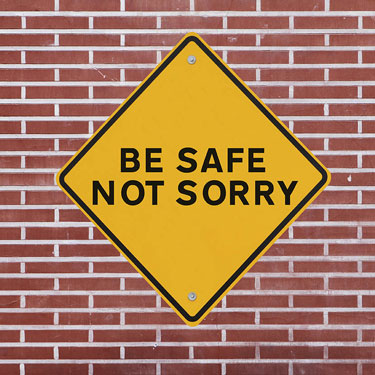Training Temp Workers to Avoid Accidents
Failing to properly train your temporary workers is an accident waiting to happen.

 Erick Ajax will never forget an explosion that shook his plant about 18 months ago.
Erick Ajax will never forget an explosion that shook his plant about 18 months ago.
“It went off like a bomb, sending pieces of shrapnel and steel flying at chest height,” he recalls. Ajax is co-owner of E.J. Ajax Metal Forming Solutions, a 63-employee metal stamping and forming manufacturer in Minneapolis.
The accident happened when a temporary employee who had been on the job less than a week tried to fix a problem with his machine without assistance—despite explicit instructions to the contrary. The worker was terminated for not following safety guidelines.
“Thank goodness no one was touched,” Ajax says.
A 27-year-old temp worker in Massachusetts was not so lucky. He was killed cleaning a machine in a food manufacturing plant when he came into contact with rotating parts and was drawn into the equipment. The company’s regular employees had received training on how to avoid such an injury, but temp employees had not.
Temporary employees account for a disproportionate percentage of workplace accidents due to a lack of familiarity with the location and equipment, inexperience, and inadequate safety training—which is why the Occupational Safety and Health Administration (OSHA) launched a temporary-worker safety initiative in April 2013.
“It’s a two-pronged effort: one of education and one of enforcement,” explains Stephen Dwyer, general counsel for the American Staffing Association in Alexandria, Va.
Although employers can do a great deal to prevent accidents, many do not.
“A lot of employers misunderstand their role,” Ajax says. “They think temps are not their responsibility. ... That is not the case.”
OSHA makes it clear that safety training for temps is the shared responsibility of the host employer and the staffing agency. Host employers should provide all temps with work-specific safety training tailored to their workplaces, even if the temps came from a staffing agency that offers its own training.
Discover the Dangers
Before conducting safety training, HR must determine the workplace risks for each job description and how long training needs to be to thoroughly address those risks. A new-hire orientation for individuals working in an office environment might last one to two hours to cover the basics, while those hired for jobs in manufacturing and health care might need training lasting eight or 12 hours, says William Yoh, chairman of Yoh Services LLC, a Philadelphia-based staffing firm with approximately 6,500 contingent workers.
At shipping company United Parcel Service (UPS), which has hired more than 90,000 temp workers for this holiday season, all workers are trained at internal facilities and warehouses across the country. In 2013, UPS spent an average of $1,246 on training per employee for both temps and regular employees.
Measuring the Effectiveness Of Temp Training
The nature of temp work makes it difficult to assess training effectiveness, since typical metrics on turnover and workers’ comp claims are impractical to measure. Experts recommend that HR:
Document the number and types of near misses. “We insist [temps] tell us about near misses because then we can do a root cause analysis and take appropriate corrective action,” says Erick Ajax, co-owner of E.J. Ajax Metal Forming Solutions. “It’s our early warning system.” Temps are not penalized for the mistake that led to the near miss; however, not reporting near misses will likely lead to termination.
Gather anecdotes from co-workers and customers. Laura Kerekes, SPHR, chief knowledge officer at ThinkHR, a cloud-based HR company, suggests getting feedback on a temp’s performance. “Survey the recipient of that temp’s work. Pick a customer you trust or an internal customer,” she says. HR professionals can also ask co-workers for their observations. This data could help identify temps who need additional safety training.
Compare defects, rework and equipment malfunctions. Similarly, comparing the number of temp workers’ failed products and equipment malfunctions with regular employees’ numbers could reveal gaps in safety knowledge.
“Seasonal workers receive the same training as regular employees. That is critical to ensuring safety,” says Mary Kay Kopp, global learning solutions director at UPS. The length of the training generally varies from a half day to five days.
Safety training at UPS covers driving, preventing slips and falls, getting in and out of a vehicle, and lifting packages. Some aspects depend on location. Drivers in Arizona might be instructed on how to prevent heat exhaustion, for example, while those in Denver learn to navigate icy sidewalks.
Even office jobs have inherent safety risks. “Building evacuation is something we go over with temps on their first day,” Ajax says. “We tell them where the fire extinguishers and emergency exits are, and where to evacuate and meet for the head count.”
Train Experientially
After determining risks, the next step is to select the best teaching method. Safety training is best imparted in person (preferably in small groups or one-on-one) at the jobsite with many hands-on demonstrations.
At E.J. Ajax, safety training sessions consist of three hours of one-on-one on-the-job interactions. The information covered includes the type of machinery temps will be using and potential workplace hazards.
However, some fundamentals can be taught via e-learning or blended learning. “For instance, you can show temps the basics of how to lift properly on the e-learning modules and then have them demonstrate what they have learned in person,” says Laura Kerekes, SPHR, chief knowledge officer at ThinkHR, a cloud-based HR compliance tool and hotline in Pleasanton, Calif.
E-learning also allows employers to maintain consistency in training.
Communicate Clearly
Clear communication among temporary workers, regular employees and staffing agencies is vital. UPS makes use of hand-held computer technology to give drivers who are on their routes guidance on how to work most effectively with a temp.
In addition, host employers should be in regular communication with the staffing agency. “Safety training must be addressed in the contract between the staffing firm and the client to ensure no misunderstanding about responsibilities,” advises the American Staffing Association’s Dwyer.
E.J. Ajax works with its staffing agency to stress its commitment to a drug-free workplace. “The staffing company does random testing at the same time we test our full-time colleagues,” Ajax says.
Maintain Detailed Records
Documenting safety training is nearly as important as conducting the training itself. At E.J. Ajax, supervisors use a training matrix that they update twice a week. It lists every employee and machine. Machines are color-coded, and employees are ranked in four categories: no experience, entry level, skilled and proficient.
“It prevents us from putting colleagues into work situations where they are not competent and capable of running a machine,” Ajax says.
The company also keeps detailed training checklists. “We have the supervisor and temporary worker sign it. Then we give a copy to the worker and the temp service, and we keep a copy,” Ajax explains. “That same document comes back out again at the 30-day review to see how the employee is doing in each area.”
Ajax says the process makes the workplace safer for everyone—and that’s no accident.
Kathryn Tyler is a freelance writer and former HR generalist and trainer in Wixom, Mich.
Advertisement
An organization run by AI is not a futuristic concept. Such technology is already a part of many workplaces and will continue to shape the labor market and HR. Here's how employers and employees can successfully manage generative AI and other AI-powered systems.
Advertisement


